BTEC HND Marketing Plan: Sri Lanka Telecom Business Analysis
VerifiedAdded on 2021/08/30
|25
|9102
|384
Report
AI Summary
This report provides a comprehensive analysis of Sri Lanka Telecom's marketing strategies, developed as part of a BTEC Higher National Diploma in Business. It begins with an overview of the company, its history, and the evolution of its marketing concept. The report delves into the marketing process at SLT, emphasizing the significance of marketing roles and responsibilities within the organization, including B2C and B2B concepts. It analyzes the interrelationships between the marketing department and other functional units, highlighting their importance in achieving organizational goals. A key focus is the application of the 7Ps marketing mix, comparing SLT's approach with that of its competitor, Dialog. The report includes an examination of key issues, internal and external environmental analyses, and future trends for SLT. It culminates in the development of a strategic marketing plan, incorporating all elements of the 7Ps, along with an action plan and evaluation metrics to meet strategic marketing goals and objectives. The report also includes a detailed comparison of the marketing strategies of SLT and its main rival, Dialog. The report seeks to provide a comprehensive understanding of the marketing landscape within Sri Lanka Telecom and offers insights into effective marketing planning and execution.
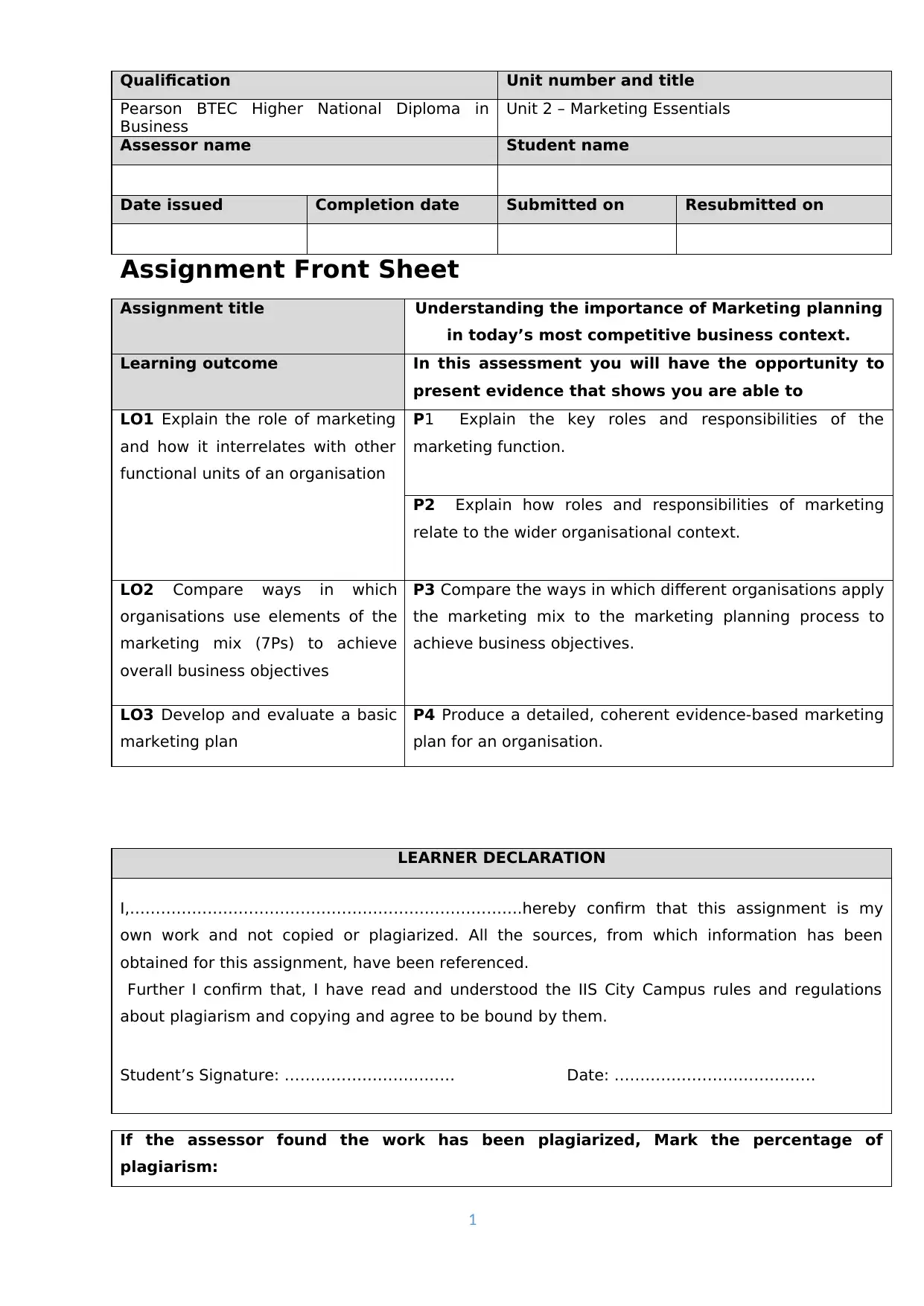
Qualification Unit number and title
Pearson BTEC Higher National Diploma in
Business
Unit 2 – Marketing Essentials
Assessor name Student name
Date issued Completion date Submitted on Resubmitted on
Assignment Front Sheet
Assignment title Understanding the importance of Marketing planning
in today’s most competitive business context.
Learning outcome In this assessment you will have the opportunity to
present evidence that shows you are able to
LO1 Explain the role of marketing
and how it interrelates with other
functional units of an organisation
P1 Explain the key roles and responsibilities of the
marketing function.
P2 Explain how roles and responsibilities of marketing
relate to the wider organisational context.
LO2 Compare ways in which
organisations use elements of the
marketing mix (7Ps) to achieve
overall business objectives
P3 Compare the ways in which different organisations apply
the marketing mix to the marketing planning process to
achieve business objectives.
LO3 Develop and evaluate a basic
marketing plan
P4 Produce a detailed, coherent evidence-based marketing
plan for an organisation.
LEARNER DECLARATION
I,………………………………………………………………….hereby confirm that this assignment is my
own work and not copied or plagiarized. All the sources, from which information has been
obtained for this assignment, have been referenced.
Further I confirm that, I have read and understood the IIS City Campus rules and regulations
about plagiarism and copying and agree to be bound by them.
Student’s Signature: …………………………… Date: …………………………………
If the assessor found the work has been plagiarized, Mark the percentage of
plagiarism:
1
Pearson BTEC Higher National Diploma in
Business
Unit 2 – Marketing Essentials
Assessor name Student name
Date issued Completion date Submitted on Resubmitted on
Assignment Front Sheet
Assignment title Understanding the importance of Marketing planning
in today’s most competitive business context.
Learning outcome In this assessment you will have the opportunity to
present evidence that shows you are able to
LO1 Explain the role of marketing
and how it interrelates with other
functional units of an organisation
P1 Explain the key roles and responsibilities of the
marketing function.
P2 Explain how roles and responsibilities of marketing
relate to the wider organisational context.
LO2 Compare ways in which
organisations use elements of the
marketing mix (7Ps) to achieve
overall business objectives
P3 Compare the ways in which different organisations apply
the marketing mix to the marketing planning process to
achieve business objectives.
LO3 Develop and evaluate a basic
marketing plan
P4 Produce a detailed, coherent evidence-based marketing
plan for an organisation.
LEARNER DECLARATION
I,………………………………………………………………….hereby confirm that this assignment is my
own work and not copied or plagiarized. All the sources, from which information has been
obtained for this assignment, have been referenced.
Further I confirm that, I have read and understood the IIS City Campus rules and regulations
about plagiarism and copying and agree to be bound by them.
Student’s Signature: …………………………… Date: …………………………………
If the assessor found the work has been plagiarized, Mark the percentage of
plagiarism:
1
Paraphrase This Document
Need a fresh take? Get an instant paraphrase of this document with our AI Paraphraser
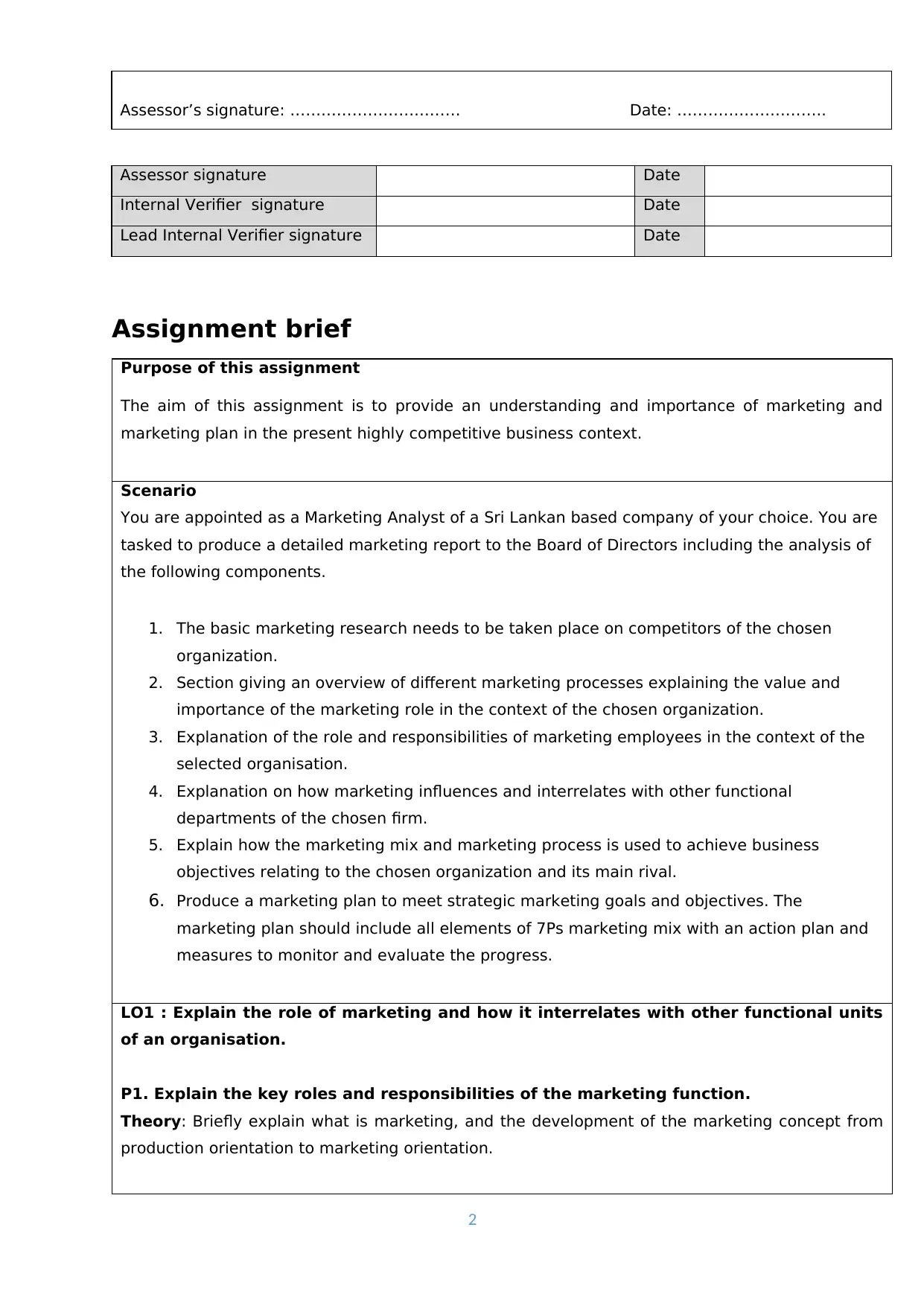
Assessor’s signature: …………………………… Date: ………………………..
Assessor signature Date
Internal Verifier signature Date
Lead Internal Verifier signature Date
Assignment brief
Purpose of this assignment
The aim of this assignment is to provide an understanding and importance of marketing and
marketing plan in the present highly competitive business context.
Scenario
You are appointed as a Marketing Analyst of a Sri Lankan based company of your choice. You are
tasked to produce a detailed marketing report to the Board of Directors including the analysis of
the following components.
1. The basic marketing research needs to be taken place on competitors of the chosen
organization.
2. Section giving an overview of different marketing processes explaining the value and
importance of the marketing role in the context of the chosen organization.
3. Explanation of the role and responsibilities of marketing employees in the context of the
selected organisation.
4. Explanation on how marketing influences and interrelates with other functional
departments of the chosen firm.
5. Explain how the marketing mix and marketing process is used to achieve business
objectives relating to the chosen organization and its main rival.
6. Produce a marketing plan to meet strategic marketing goals and objectives. The
marketing plan should include all elements of 7Ps marketing mix with an action plan and
measures to monitor and evaluate the progress.
LO1 : Explain the role of marketing and how it interrelates with other functional units
of an organisation.
P1. Explain the key roles and responsibilities of the marketing function.
Theory: Briefly explain what is marketing, and the development of the marketing concept from
production orientation to marketing orientation.
2
Assessor signature Date
Internal Verifier signature Date
Lead Internal Verifier signature Date
Assignment brief
Purpose of this assignment
The aim of this assignment is to provide an understanding and importance of marketing and
marketing plan in the present highly competitive business context.
Scenario
You are appointed as a Marketing Analyst of a Sri Lankan based company of your choice. You are
tasked to produce a detailed marketing report to the Board of Directors including the analysis of
the following components.
1. The basic marketing research needs to be taken place on competitors of the chosen
organization.
2. Section giving an overview of different marketing processes explaining the value and
importance of the marketing role in the context of the chosen organization.
3. Explanation of the role and responsibilities of marketing employees in the context of the
selected organisation.
4. Explanation on how marketing influences and interrelates with other functional
departments of the chosen firm.
5. Explain how the marketing mix and marketing process is used to achieve business
objectives relating to the chosen organization and its main rival.
6. Produce a marketing plan to meet strategic marketing goals and objectives. The
marketing plan should include all elements of 7Ps marketing mix with an action plan and
measures to monitor and evaluate the progress.
LO1 : Explain the role of marketing and how it interrelates with other functional units
of an organisation.
P1. Explain the key roles and responsibilities of the marketing function.
Theory: Briefly explain what is marketing, and the development of the marketing concept from
production orientation to marketing orientation.
2
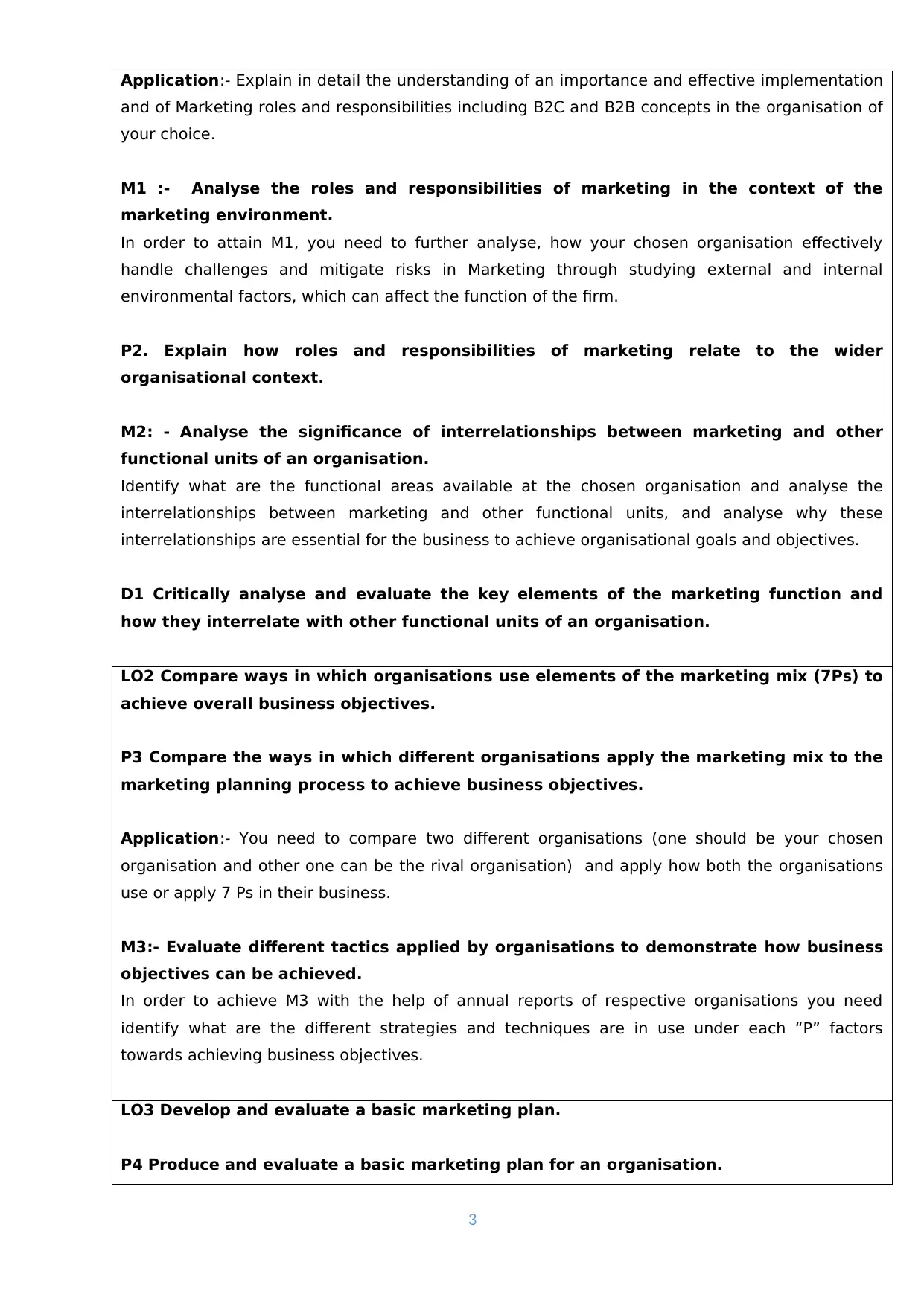
Application:- Explain in detail the understanding of an importance and effective implementation
and of Marketing roles and responsibilities including B2C and B2B concepts in the organisation of
your choice.
M1 :- Analyse the roles and responsibilities of marketing in the context of the
marketing environment.
In order to attain M1, you need to further analyse, how your chosen organisation effectively
handle challenges and mitigate risks in Marketing through studying external and internal
environmental factors, which can affect the function of the firm.
P2. Explain how roles and responsibilities of marketing relate to the wider
organisational context.
M2: - Analyse the significance of interrelationships between marketing and other
functional units of an organisation.
Identify what are the functional areas available at the chosen organisation and analyse the
interrelationships between marketing and other functional units, and analyse why these
interrelationships are essential for the business to achieve organisational goals and objectives.
D1 Critically analyse and evaluate the key elements of the marketing function and
how they interrelate with other functional units of an organisation.
LO2 Compare ways in which organisations use elements of the marketing mix (7Ps) to
achieve overall business objectives.
P3 Compare the ways in which different organisations apply the marketing mix to the
marketing planning process to achieve business objectives.
Application:- You need to compare two different organisations (one should be your chosen
organisation and other one can be the rival organisation) and apply how both the organisations
use or apply 7 Ps in their business.
M3:- Evaluate different tactics applied by organisations to demonstrate how business
objectives can be achieved.
In order to achieve M3 with the help of annual reports of respective organisations you need
identify what are the different strategies and techniques are in use under each “P” factors
towards achieving business objectives.
LO3 Develop and evaluate a basic marketing plan.
P4 Produce and evaluate a basic marketing plan for an organisation.
3
and of Marketing roles and responsibilities including B2C and B2B concepts in the organisation of
your choice.
M1 :- Analyse the roles and responsibilities of marketing in the context of the
marketing environment.
In order to attain M1, you need to further analyse, how your chosen organisation effectively
handle challenges and mitigate risks in Marketing through studying external and internal
environmental factors, which can affect the function of the firm.
P2. Explain how roles and responsibilities of marketing relate to the wider
organisational context.
M2: - Analyse the significance of interrelationships between marketing and other
functional units of an organisation.
Identify what are the functional areas available at the chosen organisation and analyse the
interrelationships between marketing and other functional units, and analyse why these
interrelationships are essential for the business to achieve organisational goals and objectives.
D1 Critically analyse and evaluate the key elements of the marketing function and
how they interrelate with other functional units of an organisation.
LO2 Compare ways in which organisations use elements of the marketing mix (7Ps) to
achieve overall business objectives.
P3 Compare the ways in which different organisations apply the marketing mix to the
marketing planning process to achieve business objectives.
Application:- You need to compare two different organisations (one should be your chosen
organisation and other one can be the rival organisation) and apply how both the organisations
use or apply 7 Ps in their business.
M3:- Evaluate different tactics applied by organisations to demonstrate how business
objectives can be achieved.
In order to achieve M3 with the help of annual reports of respective organisations you need
identify what are the different strategies and techniques are in use under each “P” factors
towards achieving business objectives.
LO3 Develop and evaluate a basic marketing plan.
P4 Produce and evaluate a basic marketing plan for an organisation.
3
⊘ This is a preview!⊘
Do you want full access?
Subscribe today to unlock all pages.

Trusted by 1+ million students worldwide
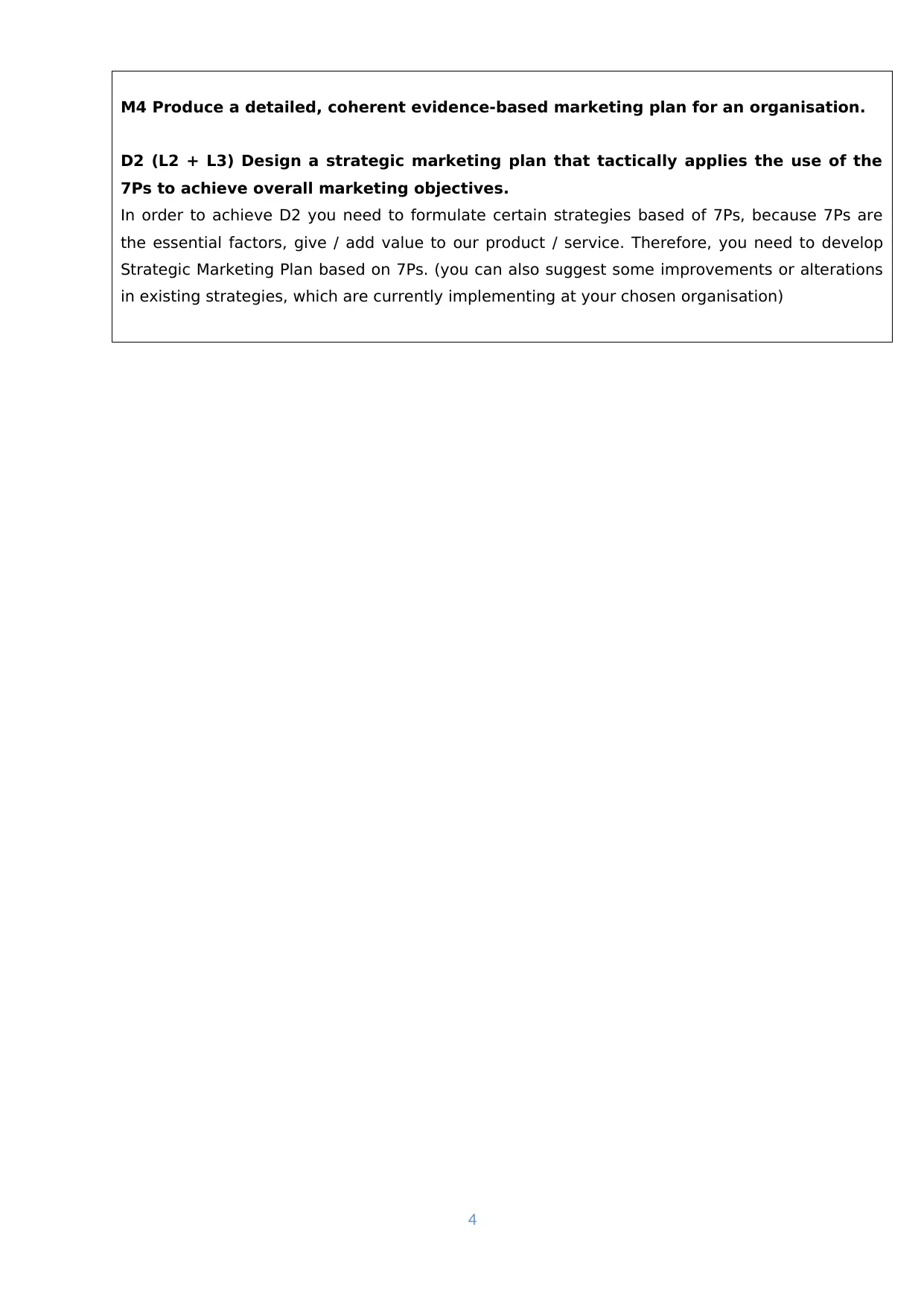
M4 Produce a detailed, coherent evidence-based marketing plan for an organisation.
D2 (L2 + L3) Design a strategic marketing plan that tactically applies the use of the
7Ps to achieve overall marketing objectives.
In order to achieve D2 you need to formulate certain strategies based of 7Ps, because 7Ps are
the essential factors, give / add value to our product / service. Therefore, you need to develop
Strategic Marketing Plan based on 7Ps. (you can also suggest some improvements or alterations
in existing strategies, which are currently implementing at your chosen organisation)
4
D2 (L2 + L3) Design a strategic marketing plan that tactically applies the use of the
7Ps to achieve overall marketing objectives.
In order to achieve D2 you need to formulate certain strategies based of 7Ps, because 7Ps are
the essential factors, give / add value to our product / service. Therefore, you need to develop
Strategic Marketing Plan based on 7Ps. (you can also suggest some improvements or alterations
in existing strategies, which are currently implementing at your chosen organisation)
4
Paraphrase This Document
Need a fresh take? Get an instant paraphrase of this document with our AI Paraphraser
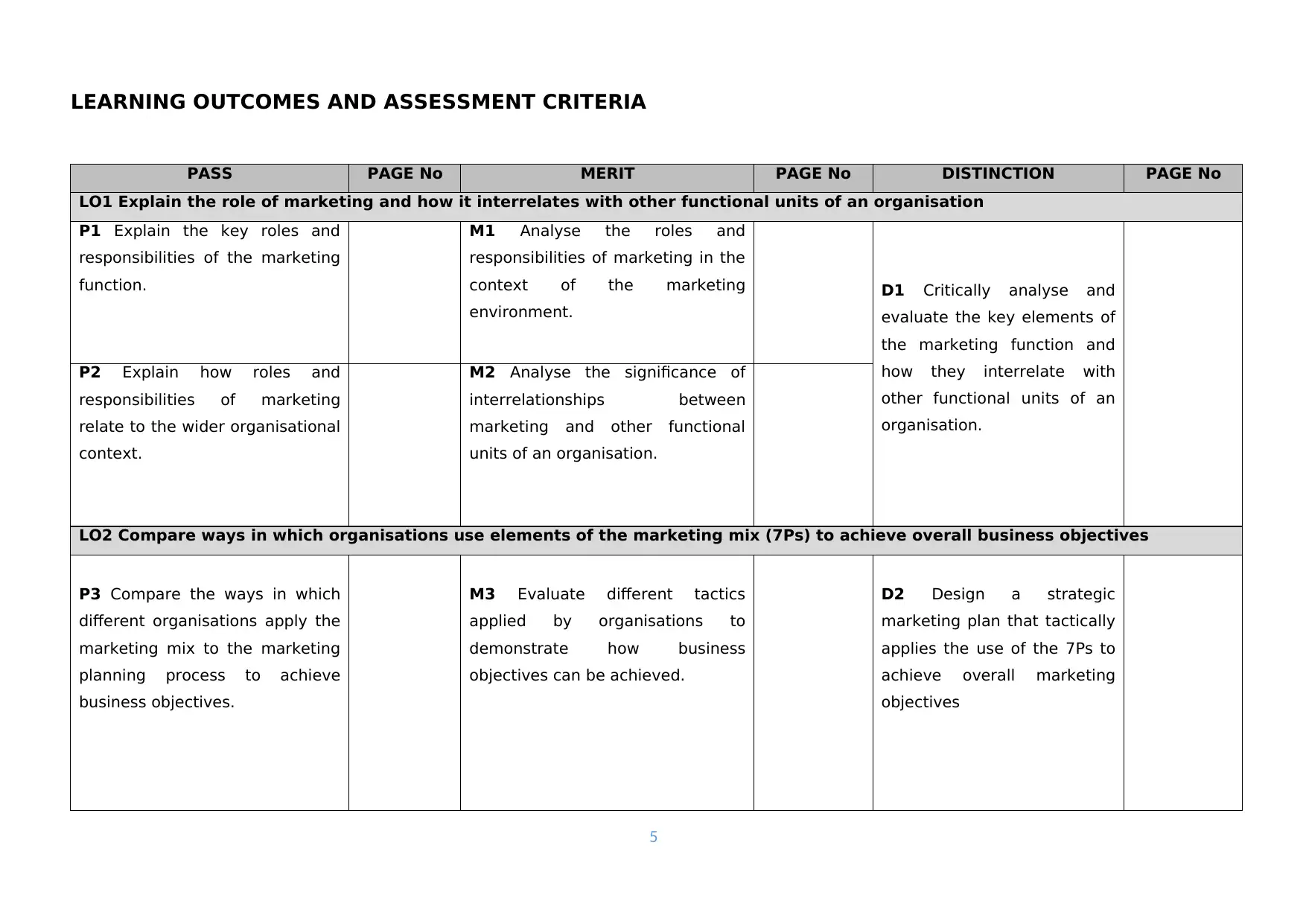
LEARNING OUTCOMES AND ASSESSMENT CRITERIA
PASS PAGE No MERIT PAGE No DISTINCTION PAGE No
LO1 Explain the role of marketing and how it interrelates with other functional units of an organisation
P1 Explain the key roles and
responsibilities of the marketing
function.
M1 Analyse the roles and
responsibilities of marketing in the
context of the marketing
environment.
D1 Critically analyse and
evaluate the key elements of
the marketing function and
how they interrelate with
other functional units of an
organisation.
P2 Explain how roles and
responsibilities of marketing
relate to the wider organisational
context.
M2 Analyse the significance of
interrelationships between
marketing and other functional
units of an organisation.
LO2 Compare ways in which organisations use elements of the marketing mix (7Ps) to achieve overall business objectives
P3 Compare the ways in which
different organisations apply the
marketing mix to the marketing
planning process to achieve
business objectives.
M3 Evaluate different tactics
applied by organisations to
demonstrate how business
objectives can be achieved.
D2 Design a strategic
marketing plan that tactically
applies the use of the 7Ps to
achieve overall marketing
objectives
5
PASS PAGE No MERIT PAGE No DISTINCTION PAGE No
LO1 Explain the role of marketing and how it interrelates with other functional units of an organisation
P1 Explain the key roles and
responsibilities of the marketing
function.
M1 Analyse the roles and
responsibilities of marketing in the
context of the marketing
environment.
D1 Critically analyse and
evaluate the key elements of
the marketing function and
how they interrelate with
other functional units of an
organisation.
P2 Explain how roles and
responsibilities of marketing
relate to the wider organisational
context.
M2 Analyse the significance of
interrelationships between
marketing and other functional
units of an organisation.
LO2 Compare ways in which organisations use elements of the marketing mix (7Ps) to achieve overall business objectives
P3 Compare the ways in which
different organisations apply the
marketing mix to the marketing
planning process to achieve
business objectives.
M3 Evaluate different tactics
applied by organisations to
demonstrate how business
objectives can be achieved.
D2 Design a strategic
marketing plan that tactically
applies the use of the 7Ps to
achieve overall marketing
objectives
5
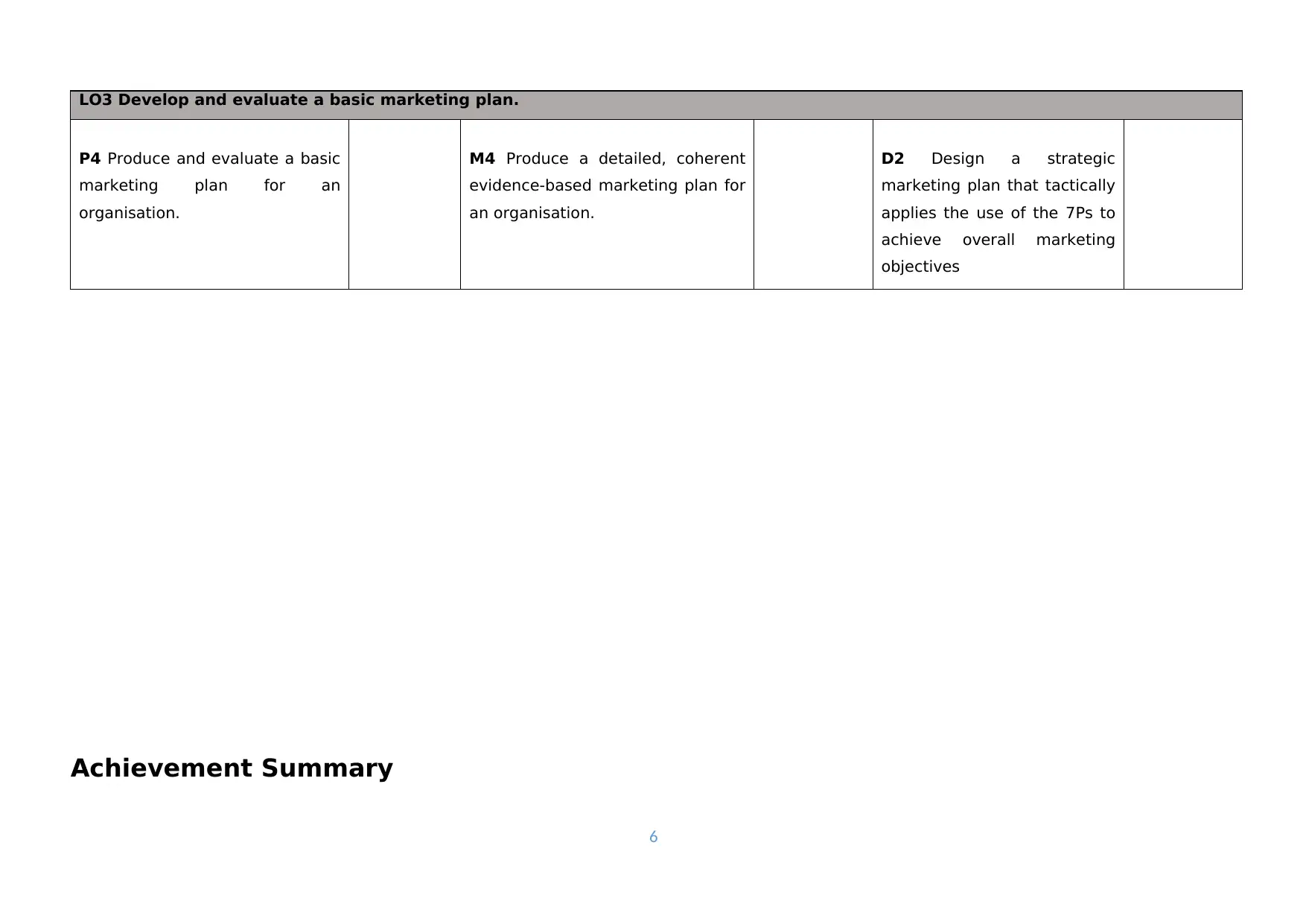
LO3 Develop and evaluate a basic marketing plan.
P4 Produce and evaluate a basic
marketing plan for an
organisation.
M4 Produce a detailed, coherent
evidence-based marketing plan for
an organisation.
D2 Design a strategic
marketing plan that tactically
applies the use of the 7Ps to
achieve overall marketing
objectives
Achievement Summary
6
P4 Produce and evaluate a basic
marketing plan for an
organisation.
M4 Produce a detailed, coherent
evidence-based marketing plan for
an organisation.
D2 Design a strategic
marketing plan that tactically
applies the use of the 7Ps to
achieve overall marketing
objectives
Achievement Summary
6
⊘ This is a preview!⊘
Do you want full access?
Subscribe today to unlock all pages.

Trusted by 1+ million students worldwide
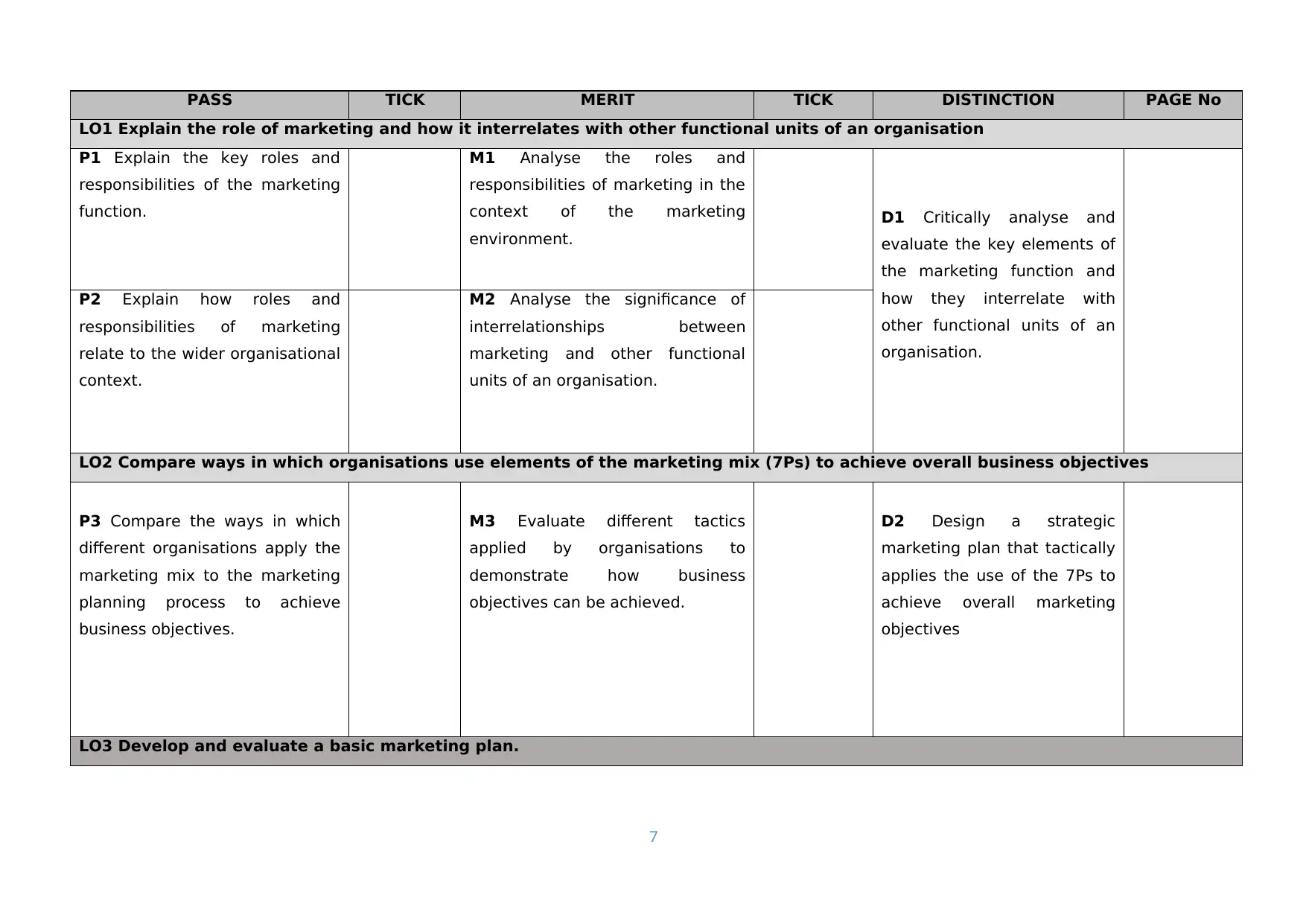
PASS TICK MERIT TICK DISTINCTION PAGE No
LO1 Explain the role of marketing and how it interrelates with other functional units of an organisation
P1 Explain the key roles and
responsibilities of the marketing
function.
M1 Analyse the roles and
responsibilities of marketing in the
context of the marketing
environment.
D1 Critically analyse and
evaluate the key elements of
the marketing function and
how they interrelate with
other functional units of an
organisation.
P2 Explain how roles and
responsibilities of marketing
relate to the wider organisational
context.
M2 Analyse the significance of
interrelationships between
marketing and other functional
units of an organisation.
LO2 Compare ways in which organisations use elements of the marketing mix (7Ps) to achieve overall business objectives
P3 Compare the ways in which
different organisations apply the
marketing mix to the marketing
planning process to achieve
business objectives.
M3 Evaluate different tactics
applied by organisations to
demonstrate how business
objectives can be achieved.
D2 Design a strategic
marketing plan that tactically
applies the use of the 7Ps to
achieve overall marketing
objectives
LO3 Develop and evaluate a basic marketing plan.
7
LO1 Explain the role of marketing and how it interrelates with other functional units of an organisation
P1 Explain the key roles and
responsibilities of the marketing
function.
M1 Analyse the roles and
responsibilities of marketing in the
context of the marketing
environment.
D1 Critically analyse and
evaluate the key elements of
the marketing function and
how they interrelate with
other functional units of an
organisation.
P2 Explain how roles and
responsibilities of marketing
relate to the wider organisational
context.
M2 Analyse the significance of
interrelationships between
marketing and other functional
units of an organisation.
LO2 Compare ways in which organisations use elements of the marketing mix (7Ps) to achieve overall business objectives
P3 Compare the ways in which
different organisations apply the
marketing mix to the marketing
planning process to achieve
business objectives.
M3 Evaluate different tactics
applied by organisations to
demonstrate how business
objectives can be achieved.
D2 Design a strategic
marketing plan that tactically
applies the use of the 7Ps to
achieve overall marketing
objectives
LO3 Develop and evaluate a basic marketing plan.
7
Paraphrase This Document
Need a fresh take? Get an instant paraphrase of this document with our AI Paraphraser
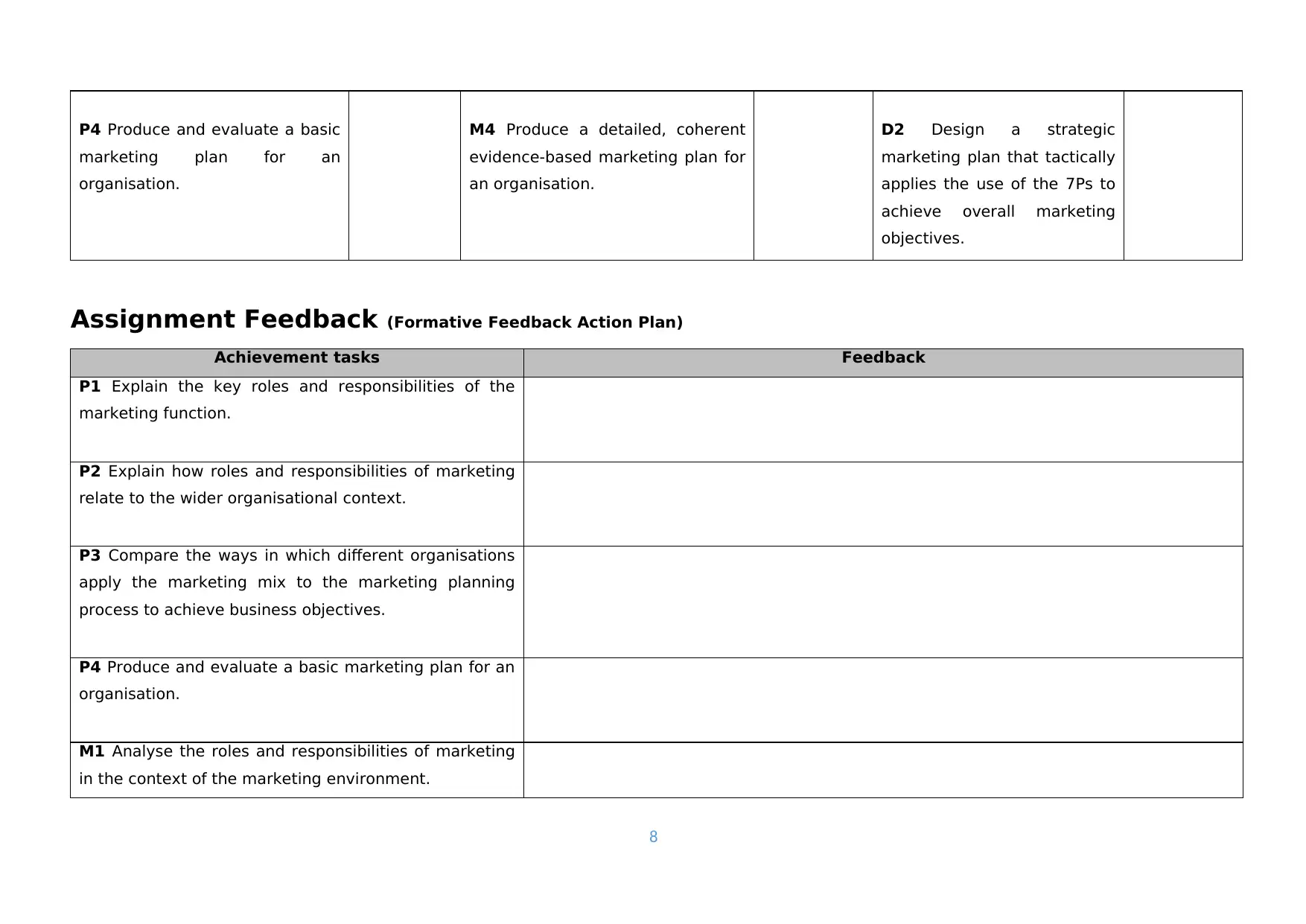
P4 Produce and evaluate a basic
marketing plan for an
organisation.
M4 Produce a detailed, coherent
evidence-based marketing plan for
an organisation.
D2 Design a strategic
marketing plan that tactically
applies the use of the 7Ps to
achieve overall marketing
objectives.
Assignment Feedback (Formative Feedback Action Plan)
Achievement tasks Feedback
P1 Explain the key roles and responsibilities of the
marketing function.
P2 Explain how roles and responsibilities of marketing
relate to the wider organisational context.
P3 Compare the ways in which different organisations
apply the marketing mix to the marketing planning
process to achieve business objectives.
P4 Produce and evaluate a basic marketing plan for an
organisation.
M1 Analyse the roles and responsibilities of marketing
in the context of the marketing environment.
8
marketing plan for an
organisation.
M4 Produce a detailed, coherent
evidence-based marketing plan for
an organisation.
D2 Design a strategic
marketing plan that tactically
applies the use of the 7Ps to
achieve overall marketing
objectives.
Assignment Feedback (Formative Feedback Action Plan)
Achievement tasks Feedback
P1 Explain the key roles and responsibilities of the
marketing function.
P2 Explain how roles and responsibilities of marketing
relate to the wider organisational context.
P3 Compare the ways in which different organisations
apply the marketing mix to the marketing planning
process to achieve business objectives.
P4 Produce and evaluate a basic marketing plan for an
organisation.
M1 Analyse the roles and responsibilities of marketing
in the context of the marketing environment.
8
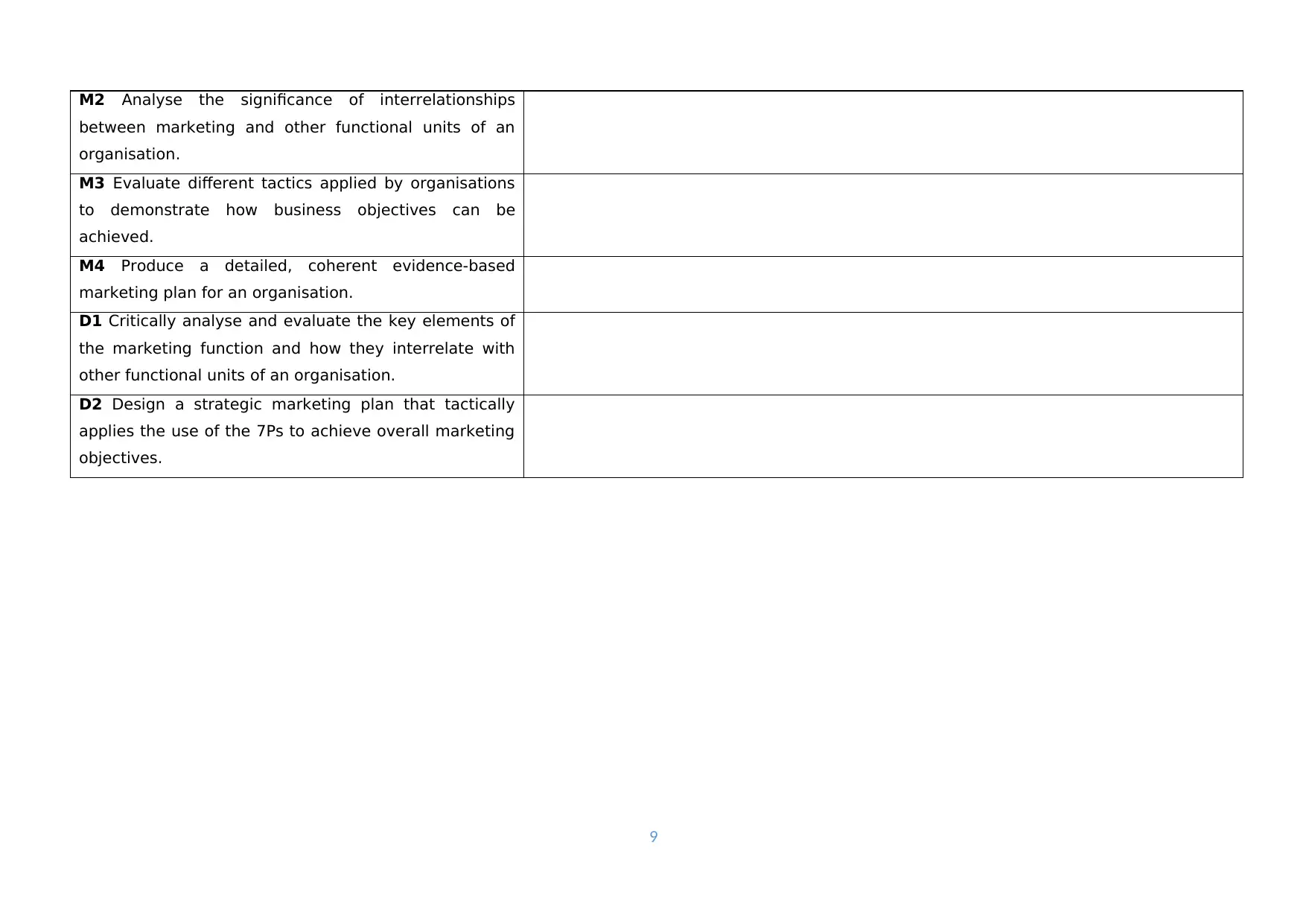
M2 Analyse the significance of interrelationships
between marketing and other functional units of an
organisation.
M3 Evaluate different tactics applied by organisations
to demonstrate how business objectives can be
achieved.
M4 Produce a detailed, coherent evidence-based
marketing plan for an organisation.
D1 Critically analyse and evaluate the key elements of
the marketing function and how they interrelate with
other functional units of an organisation.
D2 Design a strategic marketing plan that tactically
applies the use of the 7Ps to achieve overall marketing
objectives.
9
between marketing and other functional units of an
organisation.
M3 Evaluate different tactics applied by organisations
to demonstrate how business objectives can be
achieved.
M4 Produce a detailed, coherent evidence-based
marketing plan for an organisation.
D1 Critically analyse and evaluate the key elements of
the marketing function and how they interrelate with
other functional units of an organisation.
D2 Design a strategic marketing plan that tactically
applies the use of the 7Ps to achieve overall marketing
objectives.
9
⊘ This is a preview!⊘
Do you want full access?
Subscribe today to unlock all pages.

Trusted by 1+ million students worldwide
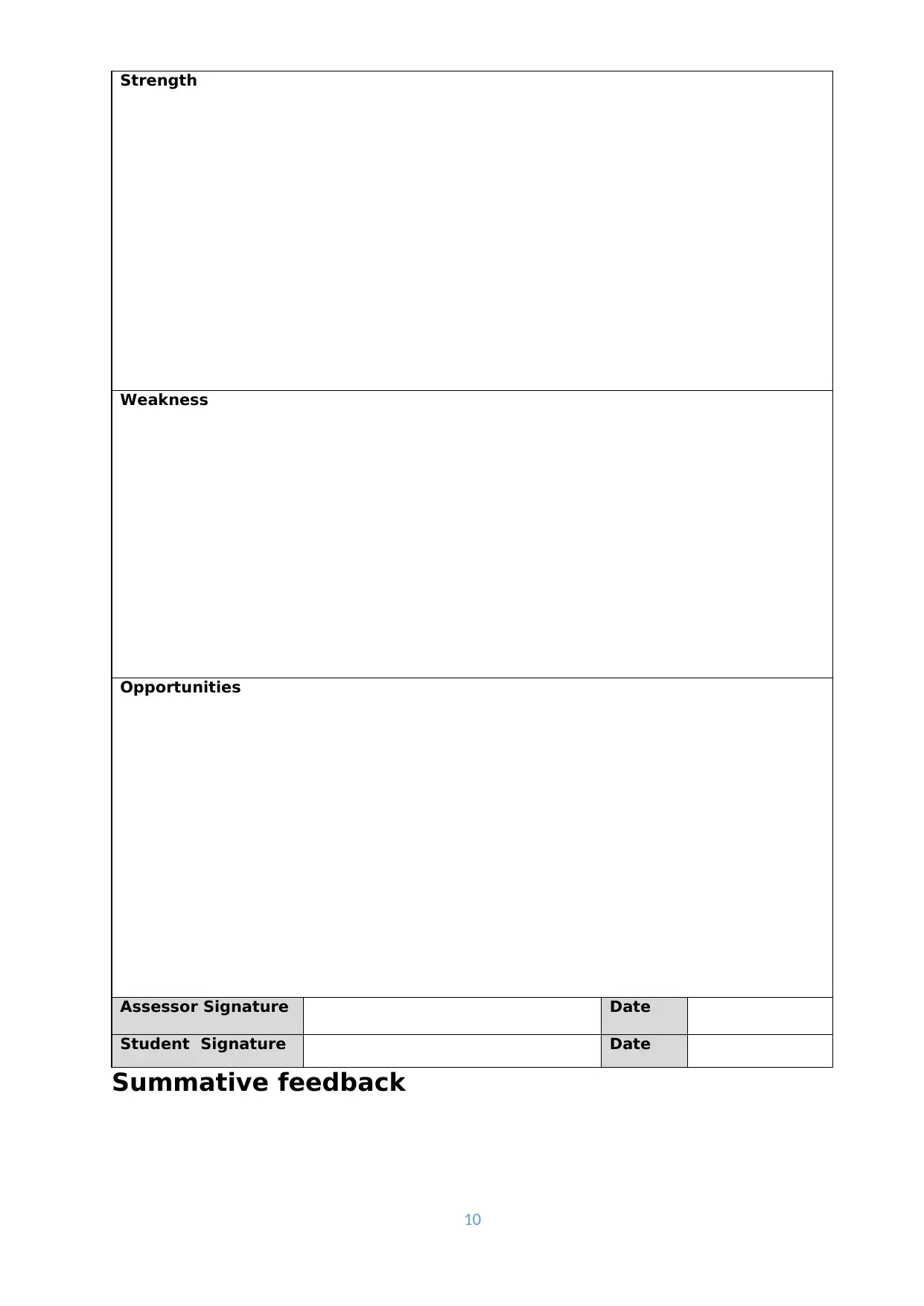
Strength
Weakness
Opportunities
Assessor Signature Date
Student Signature Date
Summative feedback
10
Weakness
Opportunities
Assessor Signature Date
Student Signature Date
Summative feedback
10
Paraphrase This Document
Need a fresh take? Get an instant paraphrase of this document with our AI Paraphraser
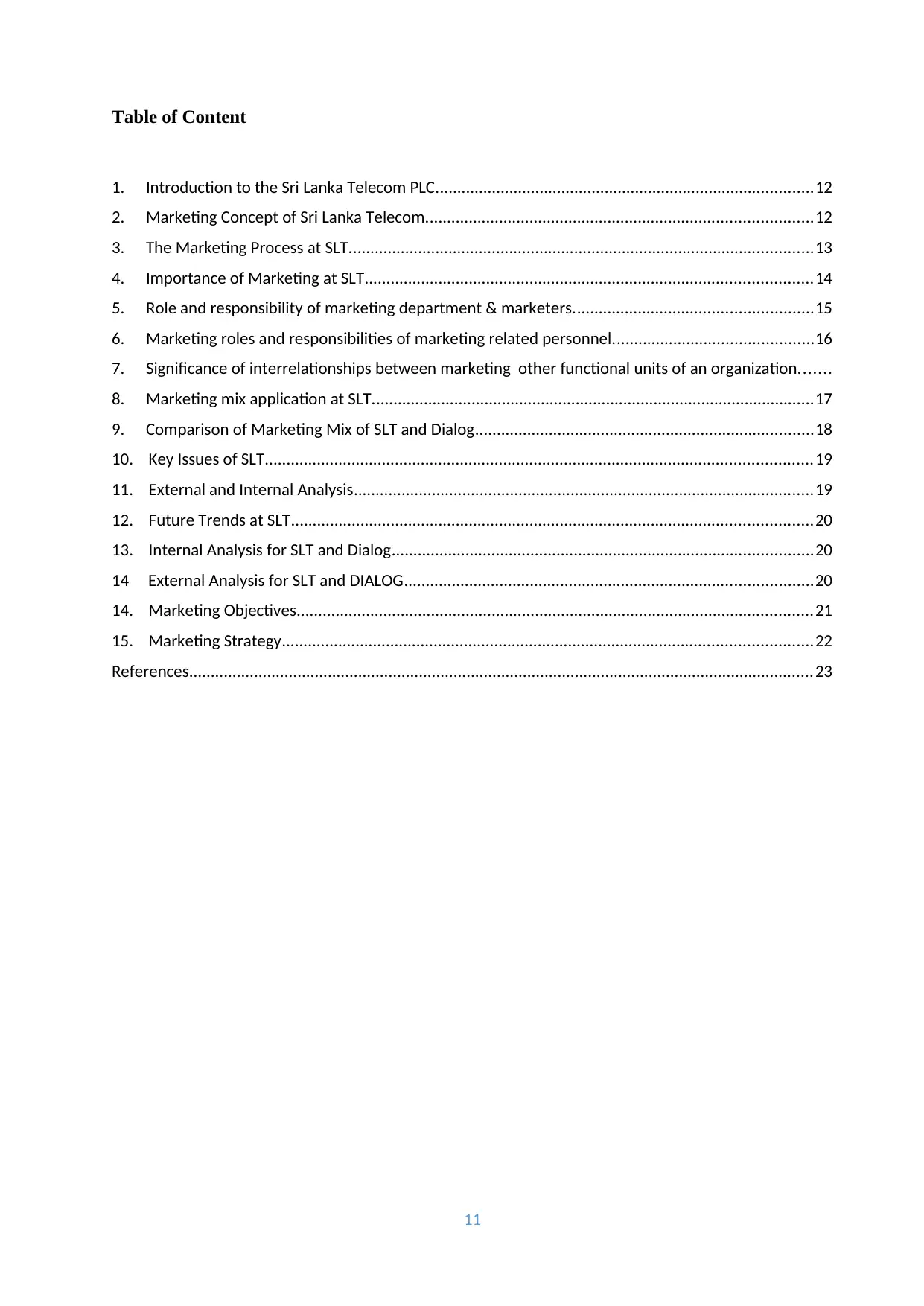
Table of Content
1. Introduction to the Sri Lanka Telecom PLC.......................................................................................12
2. Marketing Concept of Sri Lanka Telecom.........................................................................................12
3. The Marketing Process at SLT...........................................................................................................13
4. Importance of Marketing at SLT.......................................................................................................14
5. Role and responsibility of marketing department & marketers.......................................................15
6. Marketing roles and responsibilities of marketing related personnel..............................................16
7. Significance of interrelationships between marketing other functional units of an organization.......
8. Marketing mix application at SLT......................................................................................................17
9. Comparison of Marketing Mix of SLT and Dialog..............................................................................18
10. Key Issues of SLT..............................................................................................................................19
11. External and Internal Analysis..........................................................................................................19
12. Future Trends at SLT........................................................................................................................20
13. Internal Analysis for SLT and Dialog.................................................................................................20
14 External Analysis for SLT and DIALOG..............................................................................................20
14. Marketing Objectives.......................................................................................................................21
15. Marketing Strategy..........................................................................................................................22
References................................................................................................................................................23
11
1. Introduction to the Sri Lanka Telecom PLC.......................................................................................12
2. Marketing Concept of Sri Lanka Telecom.........................................................................................12
3. The Marketing Process at SLT...........................................................................................................13
4. Importance of Marketing at SLT.......................................................................................................14
5. Role and responsibility of marketing department & marketers.......................................................15
6. Marketing roles and responsibilities of marketing related personnel..............................................16
7. Significance of interrelationships between marketing other functional units of an organization.......
8. Marketing mix application at SLT......................................................................................................17
9. Comparison of Marketing Mix of SLT and Dialog..............................................................................18
10. Key Issues of SLT..............................................................................................................................19
11. External and Internal Analysis..........................................................................................................19
12. Future Trends at SLT........................................................................................................................20
13. Internal Analysis for SLT and Dialog.................................................................................................20
14 External Analysis for SLT and DIALOG..............................................................................................20
14. Marketing Objectives.......................................................................................................................21
15. Marketing Strategy..........................................................................................................................22
References................................................................................................................................................23
11
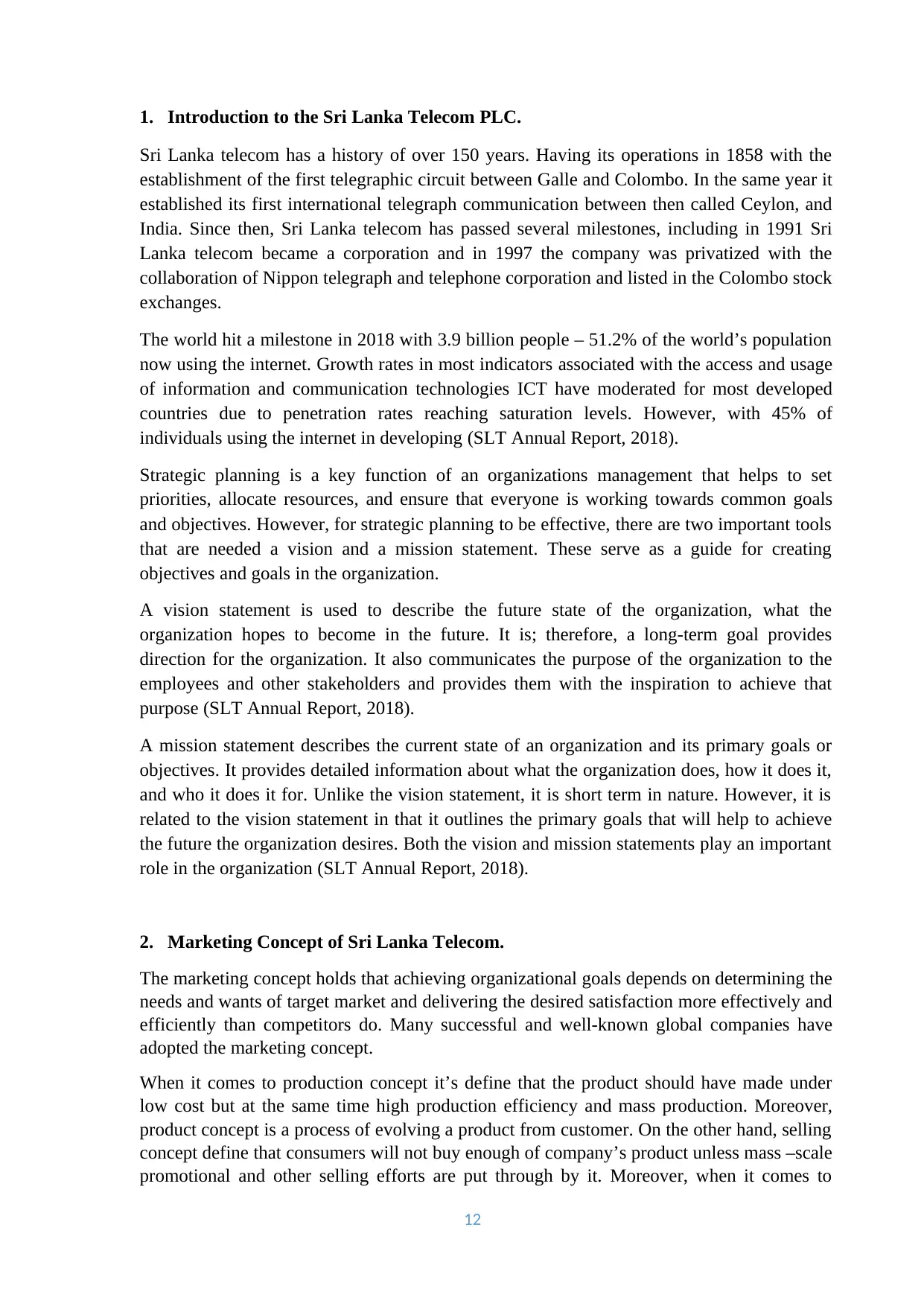
1. Introduction to the Sri Lanka Telecom PLC.
Sri Lanka telecom has a history of over 150 years. Having its operations in 1858 with the
establishment of the first telegraphic circuit between Galle and Colombo. In the same year it
established its first international telegraph communication between then called Ceylon, and
India. Since then, Sri Lanka telecom has passed several milestones, including in 1991 Sri
Lanka telecom became a corporation and in 1997 the company was privatized with the
collaboration of Nippon telegraph and telephone corporation and listed in the Colombo stock
exchanges.
The world hit a milestone in 2018 with 3.9 billion people – 51.2% of the world’s population
now using the internet. Growth rates in most indicators associated with the access and usage
of information and communication technologies ICT have moderated for most developed
countries due to penetration rates reaching saturation levels. However, with 45% of
individuals using the internet in developing (SLT Annual Report, 2018).
Strategic planning is a key function of an organizations management that helps to set
priorities, allocate resources, and ensure that everyone is working towards common goals
and objectives. However, for strategic planning to be effective, there are two important tools
that are needed a vision and a mission statement. These serve as a guide for creating
objectives and goals in the organization.
A vision statement is used to describe the future state of the organization, what the
organization hopes to become in the future. It is; therefore, a long-term goal provides
direction for the organization. It also communicates the purpose of the organization to the
employees and other stakeholders and provides them with the inspiration to achieve that
purpose (SLT Annual Report, 2018).
A mission statement describes the current state of an organization and its primary goals or
objectives. It provides detailed information about what the organization does, how it does it,
and who it does it for. Unlike the vision statement, it is short term in nature. However, it is
related to the vision statement in that it outlines the primary goals that will help to achieve
the future the organization desires. Both the vision and mission statements play an important
role in the organization (SLT Annual Report, 2018).
2. Marketing Concept of Sri Lanka Telecom.
The marketing concept holds that achieving organizational goals depends on determining the
needs and wants of target market and delivering the desired satisfaction more effectively and
efficiently than competitors do. Many successful and well-known global companies have
adopted the marketing concept.
When it comes to production concept it’s define that the product should have made under
low cost but at the same time high production efficiency and mass production. Moreover,
product concept is a process of evolving a product from customer. On the other hand, selling
concept define that consumers will not buy enough of company’s product unless mass –scale
promotional and other selling efforts are put through by it. Moreover, when it comes to
12
Sri Lanka telecom has a history of over 150 years. Having its operations in 1858 with the
establishment of the first telegraphic circuit between Galle and Colombo. In the same year it
established its first international telegraph communication between then called Ceylon, and
India. Since then, Sri Lanka telecom has passed several milestones, including in 1991 Sri
Lanka telecom became a corporation and in 1997 the company was privatized with the
collaboration of Nippon telegraph and telephone corporation and listed in the Colombo stock
exchanges.
The world hit a milestone in 2018 with 3.9 billion people – 51.2% of the world’s population
now using the internet. Growth rates in most indicators associated with the access and usage
of information and communication technologies ICT have moderated for most developed
countries due to penetration rates reaching saturation levels. However, with 45% of
individuals using the internet in developing (SLT Annual Report, 2018).
Strategic planning is a key function of an organizations management that helps to set
priorities, allocate resources, and ensure that everyone is working towards common goals
and objectives. However, for strategic planning to be effective, there are two important tools
that are needed a vision and a mission statement. These serve as a guide for creating
objectives and goals in the organization.
A vision statement is used to describe the future state of the organization, what the
organization hopes to become in the future. It is; therefore, a long-term goal provides
direction for the organization. It also communicates the purpose of the organization to the
employees and other stakeholders and provides them with the inspiration to achieve that
purpose (SLT Annual Report, 2018).
A mission statement describes the current state of an organization and its primary goals or
objectives. It provides detailed information about what the organization does, how it does it,
and who it does it for. Unlike the vision statement, it is short term in nature. However, it is
related to the vision statement in that it outlines the primary goals that will help to achieve
the future the organization desires. Both the vision and mission statements play an important
role in the organization (SLT Annual Report, 2018).
2. Marketing Concept of Sri Lanka Telecom.
The marketing concept holds that achieving organizational goals depends on determining the
needs and wants of target market and delivering the desired satisfaction more effectively and
efficiently than competitors do. Many successful and well-known global companies have
adopted the marketing concept.
When it comes to production concept it’s define that the product should have made under
low cost but at the same time high production efficiency and mass production. Moreover,
product concept is a process of evolving a product from customer. On the other hand, selling
concept define that consumers will not buy enough of company’s product unless mass –scale
promotional and other selling efforts are put through by it. Moreover, when it comes to
12
⊘ This is a preview!⊘
Do you want full access?
Subscribe today to unlock all pages.

Trusted by 1+ million students worldwide
1 out of 25
Related Documents
Your All-in-One AI-Powered Toolkit for Academic Success.
+13062052269
info@desklib.com
Available 24*7 on WhatsApp / Email
![[object Object]](/_next/static/media/star-bottom.7253800d.svg)
Unlock your academic potential
Copyright © 2020–2025 A2Z Services. All Rights Reserved. Developed and managed by ZUCOL.





